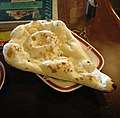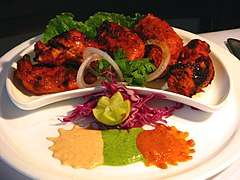Appam
Appam (Tamil: ஆப்பம், Malayalam: അപ്പം, Sinhala: ආප්ප) is a type of pancake, originating from South India, made with fermented rice batter and coconut milk, common in Tamil Nadu, Sri Lanka and Kerala.[1][2][3][4][5][6] It is eaten most frequently for breakfast or dinner.
Appam | |
| Alternative names | Hoppers, Ãppa, kallappam, vellappam, palappam |
|---|---|
| Type | Pancake or griddle cake |
| Course | Breakfast or dinner |
| Associated national cuisine | India |
| Main ingredients | Rice batter |
| Variations | Egg hoppers |
History
Vir Sanghvi, an Indian journalist, quotes food historian K. T. Achaya and states that the appam is mentioned in the Tamil Perumpanuru.[5][7][8] K. T. Achaya in the last published book of his lifetime states that Appam was well established in ancient Tamil country.
Variations
_from_Kerala%2C_India.jpg)
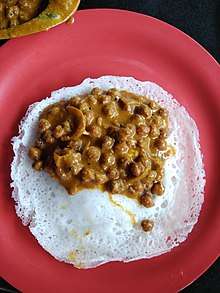
Plain appam
Plain Appam or Vella Appam are bowl-shaped thin pancakes made from fermented rice flour. They derive their shape from the small appachatti in which they are cooked. They are fairly neutral in taste and mostly served with some spicy condiment or curry. These hoppers are made from a batter using rice, yeast, salt and a little sugar. After the mixture has stood for a couple of hours, it can be fried in the appachatti with a little oil.
Egg appam

They are same as plain appams, but an egg is broken into the pancake as it cooks.
Idiyappam
Idiyappam (string hopper or noolputtu) is made from rice noodles curled into flat spirals. It is served for breakfast with a thin fish or chicken curry, containing only one or two pieces of meat, a dhal (lentil) dish, and a spicy sambol or fresh chutney. Sodhi, a type of coconut milk curry, is another popular accompaniment to idiyappam. String hoppers are made from steamed rice flour made into a dough with water and a little salt, and forced through a mould similar to those used for pasta to make the strings. They are cooked by steaming. Some people even sprinkle grated coconut on the rice noodles. These hoppers can be bought ready-made. The Indian and Sri Lankan population eats string hoppers for breakfast or dinner. There are many variations to this, depending on the type of flour used etc. This simple dish can be adapted into other foods such as string hopper Biriyani, by adding scrambled eggs or vegetables.[9] Another example is located in Kerala, 'Idiyappam' Paaya (goat leg soup made using coconut).
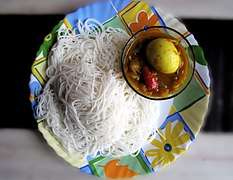
Achappam
Achappam is a deep fried rose cookie made with rice. It is a signature Christians food.
Kuzhalappam
Kuzhalappam is a typical kerala Christian dish which is a fried crisp curled up like a tube.
Neyyappam
Neyyappam owes its origins to Kerala and has been a traditional offering in Hindu temples for God. It is a signature food of christians. However, the snack originally originated from Kerala and is even now a favorite snack for every Keralite and not only for Christians. It is made with rice flour, jaggery, clarified butter ghee, which is the traditional method of making Nei appam. Again, the different culture and religious practices introduced variations to the dish as described in the citation above
Unni appam is a variation in which mashed plantain is added to the batter. The batter is made out of rice flour, jaggery and plantain is poured into a vessel called appakarai or appakaram, which has ghee heated to a high temperature. The appams take the shape of small cups and are fried until deep brown.
Pesaha appam
Pesaha appam is made by Christians in Kerala during Pesaha (Passover). This type of appam is dipped in syrup or Pesaha Pal (Passover Coconut Milk) before being served.
Vattayappam
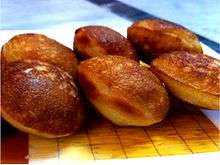
Vattayappam is made from rice flour, sugar, and coconut. It is an oil free tea time snack in majority of households in Kerala.[10] The dish is made by steam-cooking the batter, and is very similar to the bánh bò from Vietnam.
Kue apem
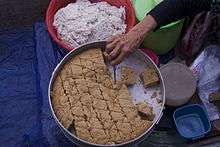
In Indonesia, a variant of appam is known as kue apem or kue apam. It is an Indonesian kue or traditional cake of steamed dough made of rice flour, coconut milk, yeast and palm sugar, usually served with grated coconut.[11] Indonesian households or community traditionally communally made kue apem for celebration and festivities. For example, Keraton Yogyakarta traditionally held Ngapem ceremony, where royal household communally cook kue apem (Javanese version of appam) as a part of Tingalan Jumenengan Dalem ceremony.[12] It is quite similar to kue mangkok. Just like kue putu it is derived from Indian influence on Indonesian cuisine.
See also
- Apam balik
- Dosa
- Uttapam
- List of fermented foods
- List of Indian breads
- List of pancakes

References
- K.T. Achaya (1997). Indian Food: A Historical Companion. Oxford University Press. ISBN 0195644166.
- Vijayan Kannampilly (2003). The Essential Kerala Cookbook. Penguin Books India. pp. 13, 14, 187. ISBN 0143029509.
- Martin Hughes; Sheema Mookherjee; Richard Delacy (2001). India, Lonely Planet World Food Guides, World Food Series. Lonely Planet. p. 201. ISBN 1864503289.
- "Rahul Gandhi has traditional Syrian Christian meal in Kerala". India Today. 13 January 2014.
- Vir Sanghvi (2004). Rude Food: The Collected Food Writings of Vir Sanghvi. Penguin Books India. p. 110. ISBN 0143031392.
- "12 Sri Lanka foods visitors have to try". CNN.
- Subhadra Sen Gupta (2012). "Always Ready for Appams!". Let's Go Time Travelling. Penguin UK. ISBN 818475678X.
- K. T. Achaya. The Story of Our Food. Universities Press. p. 80. ISBN 81-7371-293-X.
- Petrina Verma Sarkar (2 March 2011). "Appams - Appam Recipe - Hoppers - Hoppers Recipe". Indianfood.about.com. Retrieved 21 November 2011.
- "Vattayappam- an oil free tea time snack - Appam - Palappam - Pesaha Appam - Kerala Cuisines - Cake - Snacks - Steamed".
- "Kue Apem Kukus" (in Indonesian). Sajian Sedap. 16 December 2010. Retrieved 25 June 2015.
- "Para Puteri Sri Sultan Luwes Membuat Apem di Prosesi Ngapem - Tribun Jogja". Tribun Jogja (in Indonesian). 14 April 2018. Retrieved 2 July 2018.

